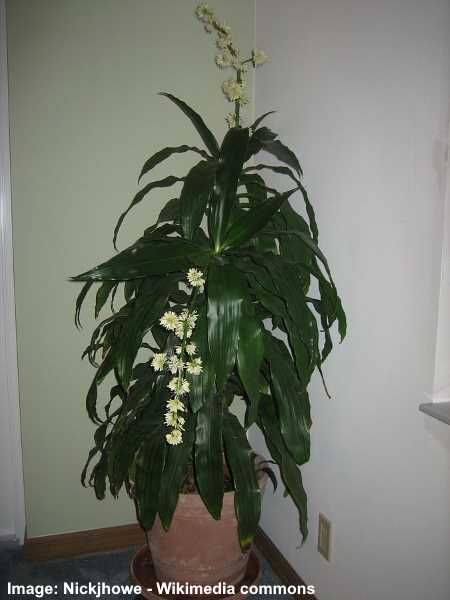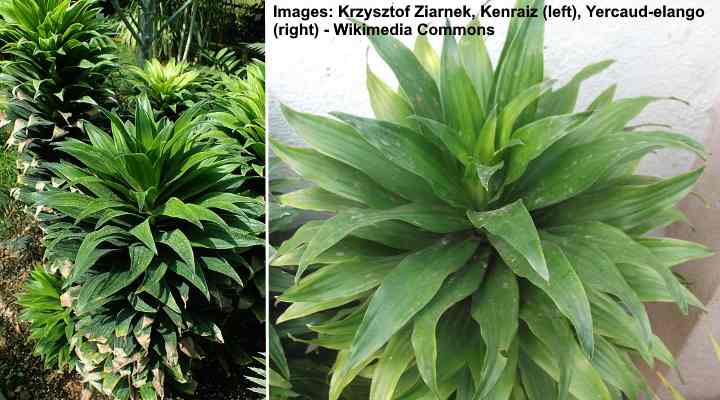Dracaena ‘Janet Craig’: Plant Care and Growing Guide (Including ‘Janet Craig’ Compacta)

Dracaena ‘Janet Craig’ (Dracaena deremensis ‘Janet Craig’ or Dracaena fragrans ‘Janet Craig’) is a popular tall houseplant that thrives in low light. ‘Janet Craig’ plants have long glossy green, lanceolate-shaped leaves that grow on straight woody stems. Their bushy foliage and tolerance of shade or bright light make Dracaena ‘Janet Craig’ ideal plants to grow indoors.
In this article, you will find out how to grow Dracaena ‘Janet Craig’ plants indoors. Along with this care guide, you’ll get handy tips on how to resolve any growing issues with these common houseplants.
How to Care for Dracaena ‘Janet Craig’ – Overview
Dracaena ‘Janet Craig’ grows best in filtered, indirect light away from direct sunlight. ‘Janet Craig’ plants thrive in average room temperatures and humidity. Plant in light, well-draining soil and only water the potting mix when the top layer dries out. Dracaena ‘Janet Craig’ plants grow well without fertilization.
Dracaena ‘Janet Craig’ Facts

Dracaena ‘Janet Craig’ houseplant
‘Janet Craig’ plants are a cultivar from the tropical slow-growing shrub Dracaena deremensis, also called Dracaena fragrans. In their native habitat of Africa, Dracaena deremensis grows up to 15 ft. (4.5 m) tall. Indoors, the ‘Janet Craig’ plants grow to about 3 ft. (1 m) tall.
The upright, woody stems have a mass of glossy dark-green leaves. ‘Janet Craig’ leaves are about 2 ft. (60 cm) long and 2” (5 cm) broad. The mass of large pointed leaves gives the indoor tree-like plant a full, bushy appearance.
Dracaena plants such as ‘Janet Craig’ are ideal floor plants to give vertical accent or height to shaded corners. This versatile plant also does well in bright indirect light, especially if you have a variegated dracaena cultivar.
If you want the ‘Janet Craig’ plants to have a full, bushy look to enhance your interior décor, make sure to buy a plant with three stalks in the pot.
Dracaena ‘Janet Craig’ Compacta

Dracaena ‘Janet Craig’ Compacta
The Dracaena deremensis ‘Janet Craig’ Compacta is a miniature version of the larger plant. The ‘Janet Craig’ Compacta has pointed lance-shaped leaves up to 5” (12 cm) long that grow from the stem at soil level. A fully-grown ‘Compacta’ dracaena plant can grow to about 6 ft. (1.8) tall outdoors. However, it takes many years for this slow-growing plant to reach that height indoors.
Due to its short growth and bushy foliage, Dracaena deremensis ‘Janet Craig’ Compacta is also called ‘Pineapple Dracaena,’ ‘Compacta Janet Craig,’ Dwarf Compacta,’ and ‘Dracaena Compacta.’
Growing a ‘Janet Craig Compacta’ indoors requires the same care as for the larger plant. The ‘Pineapple Dracaena’ thrives in indirect light or shade and average room temperatures. Only water the ‘Dracaena Compacta’ occasionally when the soil dries.
How to Care for Dracaena ‘Janet Craig’ Plant (Dracaena deremensis ‘Janet Craig’)
Dracaena ‘Janet Craig’ is an easy-to-grow houseplant—which is one reason it’s so popular. The most crucial care tip is not to overwater ‘Janet Craig’ plants as their roots are susceptible to root rot. If you water the plant enough and keep it out of direct sunlight, it should grow for many years.
Here is our detailed care guide for growing Dracaena deremensis ‘Janet Craig.’
Light Requirements for Growing Dracaena ‘Janet Craig’ Plant Indoors
Dracaena ‘Janet Craig’ grows best in bright, indirect light. This dracaena plant species is also a low-light houseplant that survives just as well in shade as it does in bright light. The best location to grow ‘Janet Craig’ plants is at an east- or north-facing window. In a south-facing room, protect the delicate foliage from direct sunlight.
Due to their tolerance of shade, ‘Janet Craig’ is an ideal plant for bedrooms, offices, dark rooms, or areas where there’s only artificial light. However, in low-light conditions, the plant’s growth slows down. You’ll also notice that growing in dark conditions, the lance-shaped leaves are narrower and smaller.
It’s vital to remember that direct sunlight can scorch the ‘Janet Craig’ plant’s leaves. If the plant grows near a south-facing window, keep it well away from the windowsill or protect it with a sheer curtain. Signs of sun leaf damage are pale patches or yellowing leaves.
The Best Soil Type for Indoor Dracaena ‘Janet Craig’ Plants
Dracaena ‘Janet Craig’ plants thrive in a loose potting mix with excellent drainage. Make the ideal dracaena potting soil by combining one part peat moss, one part compost, and one part perlite. Or you could buy a commercial potting mix for houseplants and amend the soil with gravel, perlite, or pumice.
The organic material, such as peat moss, is light and airy. This houseplant soil ingredient provides nutrients and retains some moisture. Amending the soil with an inorganic material such as gravel or perlite loosens the soil mixture to allow water to drain freely. This type of potting mix helps your dracaena plants to thrive indoors.
The right type of potting soil for Dracaena ‘Janet Craig’ plants is crucial for healthy growth. If the soil is dense and heavy, too much moisture stays in the growing medium. Waterlogged soil causes root rot and several other growing issues. If you notice that water pools on the surface or drains slowly, you’ll need to amend the soil to loosen it.
How to Water Dracaena ‘Janet Craig’ Plants
Only water Dracaena ‘Janet Craig’ as often as the top layer of soil dries. Overwatering a dracaena plant causes roots to decay, rot, and, ultimately, kill the plant. Before watering, check that the top 2” to 3” (5 – 7.5 cm) is dry. Then thoroughly drench the soil and let the excess water completely drain.
If your ‘Janet Craig’ plant is growing in bright, indirect light during summer, you may have to water the plant every week. However, if the dracaena is in continual shade during winter, only water the plant as often as every two or three weeks. However, always let soil dryness—not a set schedule—determine how frequently to water your plant.
It’s also good to remember that certain conditions can affect watering frequency. Here are some handy tips for watering ‘Janet Craig’ plants:
- Type of pot—Moisture from soil evaporates faster from terracotta pots than plastic or glazed ones. So, soil becomes drier quicker in clay pots and, therefore, the houseplant needs more frequent watering.
- Season—Plants need more water when growth is vigorous. For Dracaena ‘Janet Craig,’ this is during spring and summer. Water the bushy green plants less often in winter.
- Temperature—Hot weather and household heating cause evaporation. So, if the climate is warm, you’ll need to increase watering frequency.
Remember that plants are especially susceptible to fungal disease if you overwater them when conditions are dark, cold, and humid.
Temperature Range for Dracaena ‘Janet Craig’ Plants
Tropical Dracaena ‘Janet Craig’ plants thrive in average room temperatures. The ideal temperature range for these plants is between 65°F and 90°F (18°C – 32°C). If the plant is constantly in temperatures below 65°F (18°C), its growth will slow down. The minimal temperature for ‘Janet Craig’ is 55°F (12°C).
Temperature is rarely an issue when growing Dracaena ‘Janet Craig’ indoors. Basically, if you feel comfortable indoors, your dracaena plant will also feel good. Only remember to keep the plant out of cold drafts during winter or the air-conditioning airflow in summer.
Dracaena ‘Janet Craig’ grows outdoors in USDA zones 10 and 11 in frost-free climates. If you take your potted plant outside in summer, place it in dappled or filtered light. When temperatures drop below 60°F (15°C), it’s best to take the plant back indoors.
It’s good to remember that in colder temperatures below 60°F (15°C), the Dracaena ‘Janet Craig’ needs protection from wind chills.
Humidity Requirements When Growing Dracaena ‘Janet Craig’ Plants
Dracaena ‘Janet Craig’ doesn’t have any particular humidity requirements growing indoors. Although native to tropical climates, the plants adapt well to dry household air. Even dry air caused by household heating or air-conditioning doesn’t affect dracaena plants’ growth rate.
You don’t need to mist the shiny lanceolate leaves when caring for Dracaena ‘Janet Craig’ indoors.
Dracaena ‘Janet Craig’ Plant Growth Rate
‘Janet Craig’ dracaena plants typically have a medium to slow growth rate. This plant species grows faster in bright light, as long as it’s protected from direct sunlight. In shaded rooms with little artificial light, the dracaena ‘Janet Craig’ becomes a slow-grower.
Although low-light conditions are sufficient for the plant’s health, move it to a brighter location if you want to speed up growth.
Dracaena ‘Janet Craig’ Plant Flowers
Dracaena ‘Janet Craig’ is a flowering species of plant. ‘Janet Craig’ flowers bloom on the end of long, thick stalks that can be 10” to 12” (25 – 30 cm) tall. Large white flower clusters give off a fragrant smell and add beauty to this popular houseplant.
There are a few things to note about ‘Janet Craig’ flowering habit. Unless growing conditions are ideal, these bushy foliage plants don’t often bloom indoors. Also, the white dracaena flowers tend to produce a sticky sap that can cause a mess. So, most plant owners cut off the buds as soon as they appear.
Dracaena ‘Janet Craig’ Plant Fertilizer Requirements
If you care for Dracaena ‘Janet Craig’ plants well, they will rarely need extra feeding. Growing indoors in pots, dracaena plants are sensitive to fertilizer salts. A buildup of these in the soil can turn dracaena leaf tips brown. It’s best to water the plant as often as it needs and grow in indirect light for healthy growth.
If you want to apply fertilizer, use a balanced houseplant fertilizer, diluted to half strength. Only fertilize once in spring and once in the summer.
Dracaena ‘Janet Craig’ Plant Pruning
Pruning Dracaena ‘Janet Craig’ helps to control its height and remove dead foliage. You can reduce the plant’s size by cutting off any section of the stem. New growth will appear at the cut. You can trim bare stems off the ‘Janet Craig’ plant in spring to improve its appearance.
You can use cut sections of the stalk to propagate the dracaena plants.
How to Propagate Dracaena ‘Janet Craig’ Plant
As with most types of cane plants, you can propagate the ‘Janet Craig’ plant using the stem cutting method.
To propagate Dracaena ‘Janet Craig’, cut the stem into sections about 5” (12 cm) long. Allow the cut stems to dry overnight (mark the top and bottom end for replanting), and place them directly in individual small pots filled with potting soil. Remember to plant the bottom end in the soil—not the other way around.
Place the pot in a bright location and keep the soil moist but not overly damp. After about three weeks, the cuttings should take root, and new leaves should start to grow. You can then transfer the dracaena cuttings into a larger, new pot.
The best time for Dracaena plant propagation is in spring or summer when growth is the most vigorous.
How to Repot Dracaena ‘Janet Craig’ Plant
Repot ‘Janet Craig’ Dracaena plants in spring when the plant becomes rootbound. Typically, you need to repot dracaenas every two to three years. Choose a new pot that is one or two sizes larger than its current one to give the roots more room to grow. Dracaena plants may become a bit limp in the first two weeks after repotting.
When repotting Dracaena ‘Janet Craig,’ remove all the old soil from the roots. Check root health to ensure there are no dead or decaying mushy roots and trim as necessary. In the new pot, use an appropriate potting mix and plant the dracaena at the same height as before. Water thoroughly.
Pests Affecting Dracaena ‘Janet Craig’ Plant Growth
Common pests that affect ‘Janet Craig’ plants are mealybugs and scale insects. Houseplant bugs can suck the life out of plants. Use a neem oil solution to get rid of plant pests naturally. Mix 2 tsp. neem oil and 1 tsp. liquid dish soap with 1 quart (1 l) of lukewarm water in a spray bottle.
To treat bug infections on your Dracaena plant, spray the neem oil solution liberally on the plant’s foliage weekly. You can also use rubbing alcohol on a cotton bud to kill small white mealybugs on contact.
Mealybugs look like small white creatures that leave behind a fuzzy white substance.
Scale insects are harder to detect. But they look like bumps of woody growth on the stems. Although scale insects don’t move, they suck the plant’s sap, slowly weakening its growth.
Diseases Affecting Dracaena ‘Janet Craig’ Plant Growth
Fungal diseases caused by root rot are common in Dracaena ‘Janet Craig’ plants if you overwater them. Soggy soil, watering too often, or poor drainage cause roots to decay slowly. By the time you notice the signs of dracaena root rot—yellow leaves and wilting growth—it may be too late to save a dying ‘Janet Craig’ plant.
If you suspect that you’ve got a problem with root rot, it’s vital to repot the ‘Janet Craig’ plant as soon as possible. Refreshing the potting mix and watering only when the soil dries may help to revive your ‘Janet Craig’ houseplant.
Are Dracaena ‘Janet Craig’ Plants Toxic?
‘Janet Craig’ Dracaena plants are poisonous to cats and dogs. The ASPCA says that Dracaena deremensis ‘Janet Craig’ contains toxic saponins. Ingesting parts of the dracaena plant can result in vomiting, loss of appetite, and excessive drooling.
FAQs About Growing Dracaena ‘Janet Craig’ Plant
‘Janet Craig’ Dracaena plants are low-maintenance, easy-care houseplants. However, there are a few things that can affect your plant’s growth.
Why are my ‘Janet Craig’ leaves turning brown?
Brown tips on Dracaena ‘Janet Craig’ leaves are usually a watering issue—either too much or too little. Check for soil dryness. If the potting mix is soggy, hold off watering until half of the soil has dried. Then thoroughly soak the soil and leave it to dry again.
If the potting mix is bone dry, you will have to increase watering frequency. Although dracaena plants are resistant to some drought, their roots need regular hydration to stay healthy. Dry soil and arid conditions can also attract fungus gnats.
The drench and dry method to water houseplants ensures that roots get enough moisture without suffering from root rot.
To get rid of brown leaves or brown-tipped leaves, you’ll need to prune them to improve the plant’s appearance.
Why are Janet Craig plant leaves turning yellow?
Dracaena leaves that turn yellow is often a sign of giving the plant too much water too often. So, wait until the soil is dry before watering the plant.
Do Dracaena ‘Janet Craig’ plants clean the air?
NASA researchers found that Dracaena deremensis ‘Janet Craig’ can help purify the air. In their experiments, scientists discovered that ‘Janet Craig’ plants and other plants in the Dracaena species can help remove indoor pollutants such as formaldehyde, toluene, and xylene.
Related articles:
